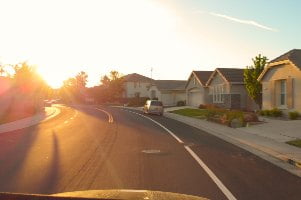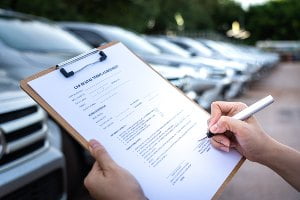 Most drivers are not that concerned about getting into a crash close to home. They assume there is much less risk because they are in a familiar area.
Most drivers are not that concerned about getting into a crash close to home. They assume there is much less risk because they are in a familiar area.
Research shows these assumptions are often false, as a large percentage of crashes happen when drivers are only a few miles away from home. It’s important to note that drivers can be just as reckless close to home as they are anywhere else.
TSR Injury Law dives into the statistics and some of the reasons why so many car crashes happen close to drivers’ homes. If you were injured in a car crash in Minneapolis, our Minneapolis-based car accident attorneys may be able to help you.
More than $1 billion recovered. No upfront fees. Call (612) TSR-TIME.
What Percentage of Car Crashes Happen Close to Home?
Research has revealed that a large percentage of car crashes happen when drivers are close to home.
According to a study published in 2015 in the Journal of Trauma Acute Care Surgery, 77.1 percent of the car crashes that were studied happened within 10 miles of the victim’s home. Another 87.6 percent happened less than 20 miles from the victim’s home. Researchers studied more than 10,000 injury incidents, including 1,644 traffic incidents.
Most Americans do not drive more than 10 or 20 miles from their homes each day. The average American drives just 29.2 miles per day, according to the AAA Foundation for Traffic Safety and the Urban Institute. The National Highway Traffic Safety Administration (NHTSA) has stated that more than 50 percent of all car crashes happen within 25 miles of drivers’ homes.
Another study from 2020 also seems to back up the idea that car crashes happen close to home. Dolphin Technologies found that 25 percent of car crashes happen within the first three minutes of a trip, with another 14 percent of crashes happen within the first six minutes of a trip.
In other words, there is a high risk of a crash on short trips in the car. Many of these trips are likely to begin at home or somewhere close to home.
Dolphin Technologies produces telematics devices that get installed in vehicles. The findings cited above are from a study of 3.2 million trips that involved 40,000 people between 2018 and 2019. There were 1,986 crashes during these 3.2 million car rides.
Another important data point from the Dolphin Technologies study is that the risk of a crash significantly increases for trips that last more than 40 minutes. Some of these drivers may have been coming home from work or from somewhere far away from their home. As they get closer to home, drivers tend to relax, often causing them to drive in a more negligent manner.
Why Most Collisions Happen Within a Few Miles of Home
There are many reasons why so many car crashes happen so close to victims’ homes.
Drivers Tend to Relax
It is only natural to feel more comfortable when you get closer to home. You are on familiar roads, and you know exactly where you are going.
Becoming relaxed and overconfident can lead to dangerous behavior behind the wheel. For example, drivers may speed, not pay as much attention to the traffic around them, or fail to stay in their lanes.
Drivers Get Tired
Drivers may be coming home from work or from a long drive, which means they may be tired. This is especially true if the crash happens at night or early in the morning.
Drivers often do not realize how tired they are and how dangerous it is to drive while drowsy. They may fall asleep at the wheel or forget to pay attention to other drivers on the road. Fatigue can impair reaction time and judgment and drivers tend to get into a trance because they have driven the route so many times before.
Even though it would be better for tired drivers to pull over and rest, many drivers try to push through their fatigue, which can be very dangerous.
Drivers Often Get Distracted
When drivers relax, they may be more likely to give in to distractions. They may start looking at their phones or sending text messages. They may look away from the road because they are eating or drinking something or playing with the car stereo.
Some of the other distractions include personal grooming, adjusting the position of the driver’s seat, and looking at distractions outside. Drivers’ concentration may drift away from the road due to a song or podcast playing on the stereo.
Drivers May be Intoxicated
People who have been drinking often decide to get behind the wheel when they only have a short distance to drive. They may think a crash is less likely to happen because they do not need to be on the road that long and they are in a familiar location. However, alcohol makes it much harder to operate your vehicle safely, even if you have taken the same route countless times before.
Drivers Often Speed
It is easier to speed in residential areas because speed limits are much lower than they are on most other roads. You may be in a rush to get to work, or you may be itching to get home from a long day out of the house. Drivers are also more likely to speed when they feel comfortable, particularly when driving in an area that is very familiar to them, often times speeding without even realizing it.
Drivers May Not Account for Residential Traffic and Parked Vehicles
The intersections and streets around your home can easily become congested with traffic. You are also more likely to encounter parked cars, pedestrians and bicyclists. People often become frustrated with this traffic, which can lead to speeding, reckless lane changes, tailgating and other dangerous behavior. Drivers may also get distracted and forget to watch for pedestrians or parked vehicles.
How Do I Avoid a Collision When I Am Close to My House?
One of the most important steps to preventing a collision close to your home is to acknowledge the risks. Research suggests you may be less safe the closer you get to home.
That means you need to take the same precautions you would when you are driving anywhere else:
Get Set Up Before You Go So You Can Focus on Driving
One of the most important steps to take before your trip is to set things up so you can stay focused on driving. For example, eat before you get in the car and get your music or podcast set up so you do not need to fiddle with it out on the road. You can also adjust the air conditioning beforehand, so you do not need to take a hand off the wheel while your car is in motion.
Finish up phone or text conversations before you leave. You should never text and drive. Phone calls while behind the wheel can also be dangerous, even if you do not have the phone in your hand.
Focus on Driving
When your car is in motion, your entire focus should be on driving. Keep your eyes on the road, keep both hands on the wheel and concentrate on being a safe driver. It is easy to lose focus by thinking about something else that is going on in your life, whether it is positive or negative. However, this can be dangerous.
While being an attentive driver is important no matter where you are, it is particularly important in residential areas.
Watch for Pedestrians, Bicyclists, Pets and Parked Cars
Drivers are conditioned to watch for other cars, but you also need to keep an eye out for pedestrians, children, people walking their dogs and bicyclists. This should be much easier to do if you are not distracted by your phone, stereo, or something else.
Obey the Speed Limit
Speeding makes a car crash much more likely to occur. You have less time to slow down to avoid a crash and you may make an evasive or risky maneuver that leads to a collision. For example, you may swerve to avoid a rear-end collision and then hit a parked vehicle or a pedestrian.
Speed limits are lower in residential areas for a reason. There can be a lot of activity and you do not want to hit a pedestrian or bicyclist at high speed as it could cause severe or fatal injuries. There are often stop signs and speed bumps and if you are going too fast you could blow through a stop sign or damage your car by going over a speed bump at a high rate of speed.
Do Not Drive if You Are Tired or Drunk
No matter how short your trip, you should never get behind the wheel when you are drunk or drowsy. Driving while fatigued or under the influence of alcohol is incredibly dangerous, as your judgment, reaction time and vision can be severely impaired. This often leads to reckless actions that make a dangerous collision much more likely.
If Possible, Walk Instead of Drive
This is not always possible, but when it is, walk to your destination or go for a bicycle ride. This is beneficial to your physical health, and it is one less car trip, which means one less opportunity for a crash. If you are tired, maybe the trip can wait until later or even the next day. While fatigued, walking may be less dangerous than driving, but both can still be risky.
Have Questions After a Minnesota Car Crash? Call Us Today
Drivers often let their guard down when they are in a familiar area, or because they are tired, distracted or under the influence of drugs or alcohol. No matter the reason, when drivers are negligent and they cause crashes that injure others, those drivers should be held accountable.
Our firm has been holding negligent drivers and liable insurance companies accountable for decades. We represent crash victims at no upfront cost. That means there is no risk in finding out how we may be able to assist you after a crash caused by another driver.
Call us today: (612) TSR-TIME. We seek full compensation for Minnesota crash victims.
 Effective May 20, 2023, there are two big changes in wrongful death claims in Minnesota. First, a personal injury claim can continue after the victim dies (even if the death was not caused by the original claim). Previously, the law stated these cases end when the victim passes away, other than a claim for unpaid medical bills. Second, there is now a claim for the pain and emotional distress suffered by the decedent when they die.
Effective May 20, 2023, there are two big changes in wrongful death claims in Minnesota. First, a personal injury claim can continue after the victim dies (even if the death was not caused by the original claim). Previously, the law stated these cases end when the victim passes away, other than a claim for unpaid medical bills. Second, there is now a claim for the pain and emotional distress suffered by the decedent when they die.


 Car crashes are difficult enough without the extra wrinkle of the at-fault driver’s vehicle being a rental car. When victims find out, they may have a lot of questions about seeking compensation for their damages.
Car crashes are difficult enough without the extra wrinkle of the at-fault driver’s vehicle being a rental car. When victims find out, they may have a lot of questions about seeking compensation for their damages. Most drivers are not that concerned about getting into a crash close to home. They assume there is much less risk because they are in a familiar area.
Most drivers are not that concerned about getting into a crash close to home. They assume there is much less risk because they are in a familiar area.